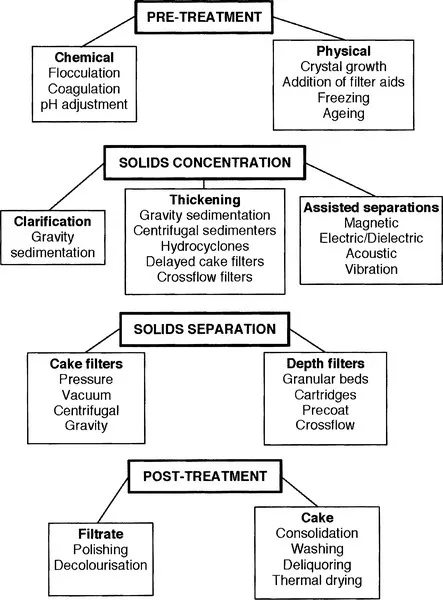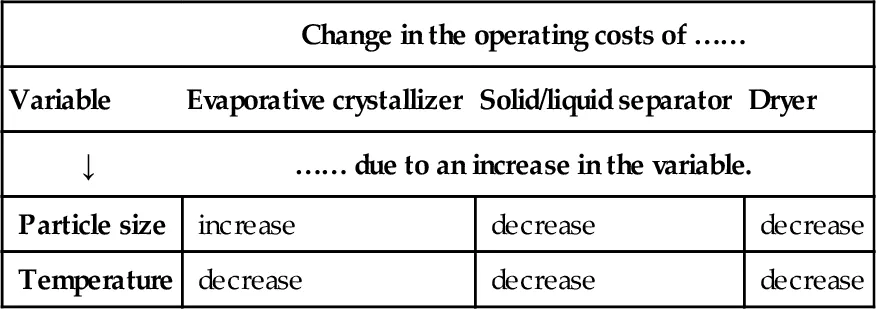
eBook - ePub
Solid/ Liquid Separation
Principles of Industrial Filtration
Stephen Tarleton, Richard Wakeman
This is a test
Buch teilen
- 340 Seiten
- English
- ePUB (handyfreundlich)
- Über iOS und Android verfügbar
eBook - ePub
Solid/ Liquid Separation
Principles of Industrial Filtration
Stephen Tarleton, Richard Wakeman
Angaben zum Buch
Buchvorschau
Inhaltsverzeichnis
Quellenangaben
Über dieses Buch
Solid/fluid separation is a major element in the processes performed in pharmaceutical, food, beverage, water, pulp and paper industries. Several books now exist on the more esoteric aspects of the techniques, but accounts of the fundemental principles involved are few.
Written by two well-known chemical engineers, this book reviews the scientific and engineering bases for solid/fluid separation processes in an approachable style. Coverage focuses on fluid dynamics, gravity, centrifugal and membrane separations, filter cake formation, de-liquoring and washing. Complete with an extensive bibliography to allow readers to pursue topics in greater depth.
- Help readers to understand how filtration processes work
- Facilitate the application of knowledge to start-up and existing processes, helping readers to improve process performance
- Help ensure your equipment is appropriate for its purpose and is working optimally, saving time and money
Häufig gestellte Fragen
Wie kann ich mein Abo kündigen?
Gehe einfach zum Kontobereich in den Einstellungen und klicke auf „Abo kündigen“ – ganz einfach. Nachdem du gekündigt hast, bleibt deine Mitgliedschaft für den verbleibenden Abozeitraum, den du bereits bezahlt hast, aktiv. Mehr Informationen hier.
(Wie) Kann ich Bücher herunterladen?
Derzeit stehen all unsere auf Mobilgeräte reagierenden ePub-Bücher zum Download über die App zur Verfügung. Die meisten unserer PDFs stehen ebenfalls zum Download bereit; wir arbeiten daran, auch die übrigen PDFs zum Download anzubieten, bei denen dies aktuell noch nicht möglich ist. Weitere Informationen hier.
Welcher Unterschied besteht bei den Preisen zwischen den Aboplänen?
Mit beiden Aboplänen erhältst du vollen Zugang zur Bibliothek und allen Funktionen von Perlego. Die einzigen Unterschiede bestehen im Preis und dem Abozeitraum: Mit dem Jahresabo sparst du auf 12 Monate gerechnet im Vergleich zum Monatsabo rund 30 %.
Was ist Perlego?
Wir sind ein Online-Abodienst für Lehrbücher, bei dem du für weniger als den Preis eines einzelnen Buches pro Monat Zugang zu einer ganzen Online-Bibliothek erhältst. Mit über 1 Million Büchern zu über 1.000 verschiedenen Themen haben wir bestimmt alles, was du brauchst! Weitere Informationen hier.
Unterstützt Perlego Text-zu-Sprache?
Achte auf das Symbol zum Vorlesen in deinem nächsten Buch, um zu sehen, ob du es dir auch anhören kannst. Bei diesem Tool wird dir Text laut vorgelesen, wobei der Text beim Vorlesen auch grafisch hervorgehoben wird. Du kannst das Vorlesen jederzeit anhalten, beschleunigen und verlangsamen. Weitere Informationen hier.
Ist Solid/ Liquid Separation als Online-PDF/ePub verfügbar?
Ja, du hast Zugang zu Solid/ Liquid Separation von Stephen Tarleton, Richard Wakeman im PDF- und/oder ePub-Format sowie zu anderen beliebten Büchern aus Technology & Engineering & Mechanical Engineering. Aus unserem Katalog stehen dir über 1 Million Bücher zur Verfügung.
Information
1
Introduction
In the simplest sense solid/liquid separation involves the separation of two phases from a suspension. Although a filter is the kernel of most solid/liquid separations, a vast array of other techniques and equipment are available to effect a separation, ranging from highly versatile units capable of handling different filtration duties to those restricted in use by the fluid properties and process conditions. Filtration, or more generally solid/liquid separation, is used in many processes with one or more aims:
1. recovery of a valuable solid component (the liquid being discarded);
2. recovery of the liquid (the solids being discarded);
3. recovery of both the solids and liquid phases; or
4. recovery of neither phase (e.g. when a liquid is being cleaned prior to discharge, as in the prevention of water pollution).
Not only is the nature of the “product” important, but a further serious consideration in the selection of solid/liquid separation equipment is whether the separation is to be effected continuously or batchwise. In the latter case the separator is operated intermittently between filling and discharge stages of its operating cycle. Scale or throughput during operation also requires careful consideration, as scale not only affects equipment size but many separator designs make them suitable for limited ranges of throughput.
1.1 The separation process
Any system design must consider all stages of solid-liquid separation, including pre-treatment, solids concentration, solids separation and post-treatment. These factors encompass the wide range of equipment and processes summarised in Figure 1.1.

Figure 1.1 Some components of the solid/liquid separation process. A number of the separation processes above may be used alternatively as pre-treatment, solids concentration or solids separation techniques.
Pre-treatment is used primarily with “difficult to filter” slurries, enabling them to be filtered more easily. A slurry may be difficult to filter for a variety of reasons — for example, a proportion of the particles in the feed may be fine and tend to block the entrances to pores in a filter medium, or the concentration of particles in the feed may be low and cause surface or internal blocking of the filter medium, or the surface chemistry of the particles may cause them to gel or be attracted to the filter medium surfaces irreversibly, and so on. Pre-treatment usually involves changing the nature of the suspended solids by either chemical or physical means, or by adding a solid (filter aid) to the suspension to act as a bulking agent to increase the permeability of the cake that is formed during filtration. Some pre-treatment processes, notably chemical processes, simultaneously change the properties of the suspending liquid.
During concentration of the solids in a suspension part of the liquid is removed, for example by gravitational or centrifugal thickening or hydrocycloning. This reduces the liquid volume throughput load on a filter and generally enables a filter cake to be formed more readily. A number of “assisted separation” techniques are also gradually making their way into the list of technical alternatives available to the separations technologist – these utilise magnetic, electrical or sonic force fields either individually or in combination to provide for a more effective separation. Although still quite uncommon in practice, their existence should be recognised.
Solids separation usually involves a filter, the types of which can be classified in many different ways. For present purposes, the divisions in Figure 1.1 indicate those separations in which a cake is formed and those where the particles are captured in the depth of the medium is adequate. These general categories hide the complexities associated with the wide range of filter types available, which often causes confusion for people who do not need to have an in-depth knowledge of filtration problems and applications. The underlying fundamental models and approaches to the analysis of solid/liquid separation problems, which can also be used for the scale-up and sizing of filter systems, are amplified in this book. Cake filters can be further divided into pressure, vacuum, centrifugal and gravity operations.
Post-treatment processes involve making improvements to the quality of the solid or liquid products. In the case of the liquid product, the filtrate, these operations are often referred to as polishing processes. Polishing may involve, for example, fine filters to remove small contaminants from the filtrate. Further purification could involve removal of ionic and macromolecular species by reverse osmosis, ion exchange or adsorption. Cake post-treatment processes include washing soluble impurities from the cake voids, and the removal of excess liquid from the voids to reduce the cake moisture content.Thermal drying is often the final stage of liquid removal from the solids that are discharged from a filter as a cake.
1.1.1 Solid/liquid separation in the process flowsheet
Solid/liquid separation is too often designed as though it is a ‘standalone’ process in a plant flowsheet — taking a traditional unit operations textbook approach. The performance of a solid/liquid separation device is sensitive to the history of the feed suspension, for example on the characteristics of the particles which result from conditions during precipitation or crystallization. Changes in the operating conditions of the particle production process often alter the mean size, the size distribution or the shape of the particles in the slurry fed to a filter, each of which can have a profound effect on the characteristics of separation and hence on the performance of a filter. This is turn means that a change in particle production conditions can affect the best choice of filter for a separation! All too often the choice of solid/liquid separation equipment is perceived to be between alternative separator types – for example between a centrifuge and a rotary vacuum filter. In fact the situation is considerably more complex as many equipment items up- and down- stream of a separator are frequently interdependent, and all ancillary equipment must be included in an analysis of the separation process. The choice of ancillary components varies according to the type of separator and the flowsheet, and on other units in the process. It is often possible to devise a multiplicity of solutions to any separation problem that lead to alternative process flowsheets.
The economics and viability of producing a product are often affected by the amount of liquid removed in post-treatment processes. For example, if the cake is to be transported, briquetted or pelletized the cake moisture content will need to be within a specified range, or if a bone dry product is required the thermal load on the dryers can be reduced by correct choice and operation of the filter.
Where interactions between process steps exist “local” and “global” trade-offs are identifiable — that is, the operation of one or more pieces of equipment may not be optimal if the overall flowsheet is optimised. Local trade-offs affect single items of equipment, whilst effects of global ones manifest themselves on the design of more than one item of equipment. Consequently the latter are of considerable importance when defining optimum design and operating conditions for a process as a whole. Consider the simple flowsheet shown in Figure 1.2 for the recovery of particles from an evaporative crystalliser. In this case particle size and temperature are major global variables and the effect of increasing either variable on the unit operation cost can be summarised as:

Figure 1.2 Possible simplified flowsheet structure for particle production.
| Change in the operating costs of …… | |||
| Variable | Evaporative crystallizer | Solid/liquid separator | Dryer |
| ↓ | …… due to an increase in the variable. | ||
| Particle size | increase | decrease | decrease |
| Temperature | decrease | decrease | decrease |
Here two different effects of global variables are observed. Increasing the particle size usually enables easier separation and less moisture in the discharged cake, resulting in reduced costs for both separation and drying. However, the crystallizer size and cost are increased and an “optimum” particle size may be sought when size is not governed by market criteria or required properties of the particle. Increasing the temperature, on the other hand, leads to lower costs in all three unit operations — hence the “best” temperature will be one close to the temperature of an available utility such as steam. This is but one quite simple example, and each process flowsheet requires investigation in its own right using information pertinent to the particular problem.
On Figure 1.2 minor global variables can also be identified between two equipment items. Operating at higher slurry densities in the crystallizer take-off can reduce the size of both the crystallizer and the separator. Producing a drier filter cake tends to increase mechanical separation costs, but reduce thermal dryer costs. Hence an optimum moisture content can be sought.
It is important, therefore, to consider simultaneously and to the same detail those unit operations that supply suspension to the solid/liquid separations plant, and the subsequent processing of the solid or liquid prod...
